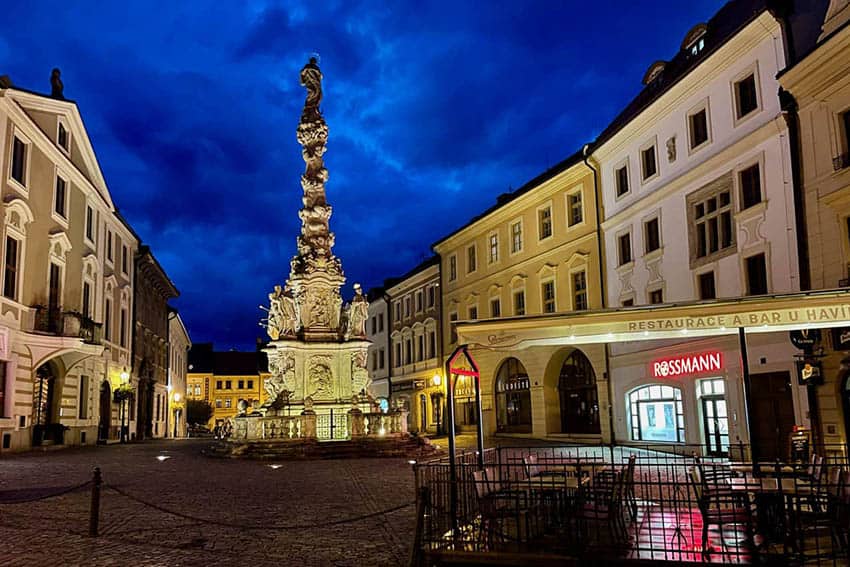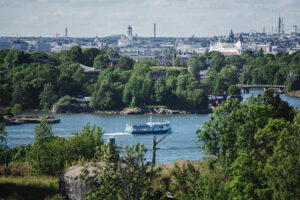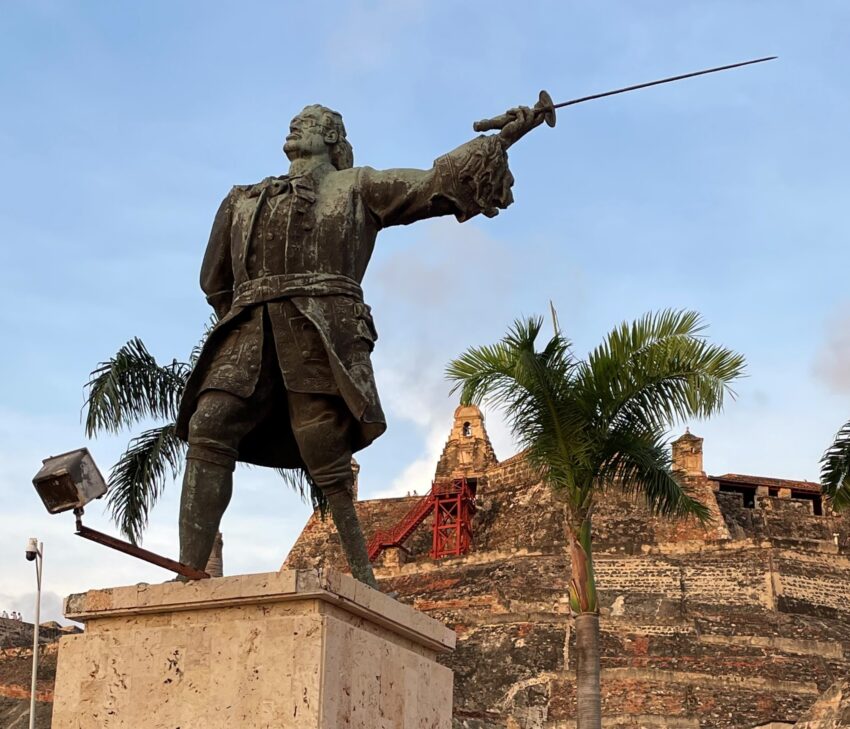
Pirates, and the Swashbuckling Spanish Towns that Made them Famous
By Rich Grant
GoNOMAD Senior Writer
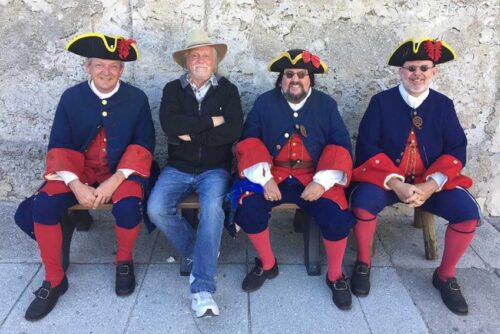
There’s never been a shortage of pirates, who are really just brigands who commit a crime at sea. But what of the towns these daring, devil-may-care buccaneers once called home?
Only a few seaports in what was the 16th, 17th, and 18th century Spanish Americas survived the plundering, gun smoke, hangings, and ransacking of the Golden Age of Piracy and still, today offer the romantic and fun spirit of the Jolly Roger.
So here’s a “yo ho ho and a bottle of rum” to the best Spanish pirate towns, and to the scallywags who once walked their streets.
Saint Augustine, Florida
America’s oldest city was founded in 1565 for one purpose: to fight pirates. At this time, huge Spanish treasure fleets filled with gold and silver looted from Mexico would gather off Florida before racing across the Atlantic to Spain.
To protect their flanks from pirates, Don Pedro Menendez de Aviles came to the hot, humid, bug-infested swamp that was Florida and laid out the first European grid-style town, a real city with streets and plazas and impressive government buildings.
Which of course all worked to attract pirates. Nine wood forts were built and destroyed by pirates in just the early years. The infamous English pirate Sir Francis Drake burned the town in 1586, 34 years before the Pilgrims landed at Plymouth Rock.
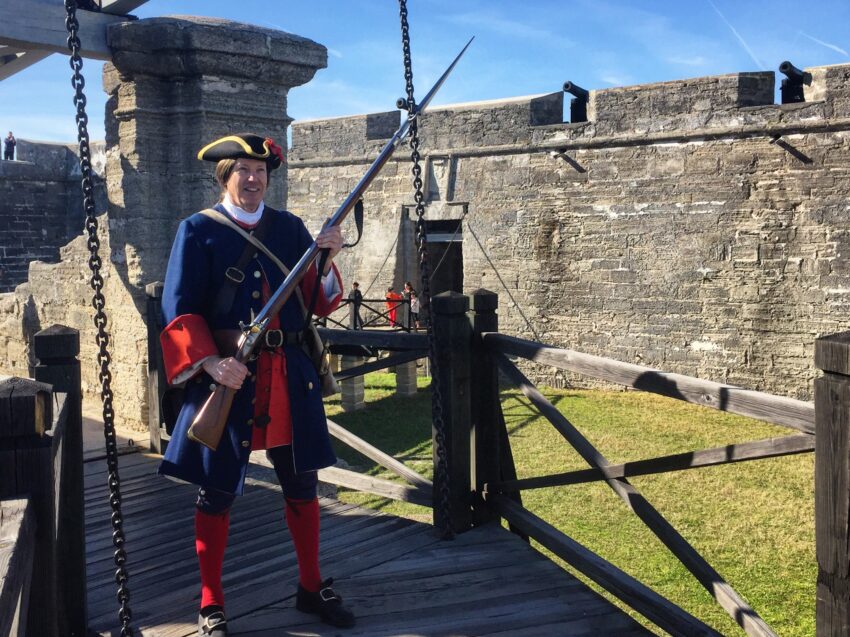
Castillo de San Marcos
Finally, in 1672, Spain had enough and construction started on the Castillo de San Marcos – the oldest and best-preserved stone fort in the United States. Today, the huge diamond-shaped fortress is a National Monument. You can walk the ramparts along the top of the towering, 28-foot-tall walls, defend the drawbridge, climb out on the bastions for a view of the harbor, and watch cannons being fired by re-enactors in Spanish uniforms.
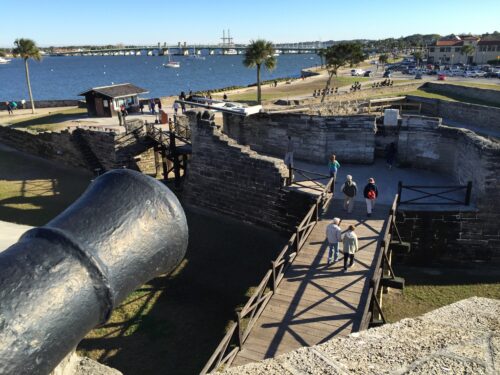
The fort was built of coquina, a soft local stone made of compressed shells. When the British attacked in 1702, the soft stone absorbed the cannonballs without crumbling, and the fort held out for 50 days.
Of course, the frustrated British had to settle for capturing the town, which they burned to the ground before sailing off. But the fort survived that battle and was never captured.
Fort Mose
Two miles north of the Castillo is the location of Fort Mose (pronounced “moe-say), which was an earthen-walled fort with Indian-style thatched huts. It was also the first legally sanctioned Black community in North America.
Spain allowed slavery, but slavery in Spain had nothing to do with race. Both Blacks and whites could be free or they could be slaves, and if slaves, they could earn their freedom by becoming Catholics and serving in the military.
Pirates also had their own views on slavery. If they captured a slave ship, they would in turn sell the slaves themselves. The first slaves brought to what would become the United States in 1609 were originally destined for South America, but were captured by pirates and ended up in Jamestown, Virginia instead.
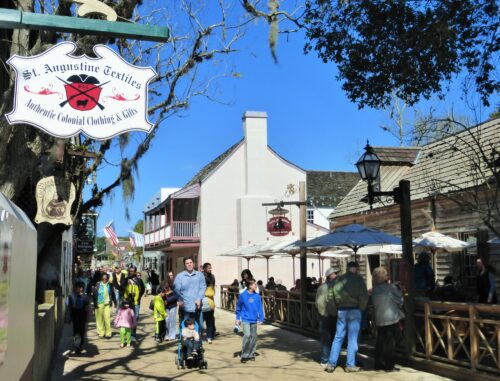
But an escaped, run-away slave? Here was a fellow outlaw and escaped Blacks were fully accepted into the pirate community as an equal.
The first escaped slaves arrived in St. Augustine in 1687 coming from British Georgia and South Carolina. When the British demanded their return, Spanish Governor Quiroga refused, establishing a fugitive slave policy for Florida. The newly freed slaves adopted Spanish names and customs, but with an African flair.
A Community of Former Slaves at Fort Mose
By 1738, a community of 100 former slaves were living in Fort Mose under the leadership of Captain Francisco Menendez, a remarkable African-born Mandingo and escaped slave, who had already fought the British in Georgia.
Of course, the British were upset with this Spanish policy, so in 1740 they sent another naval force to attack and destroy the Castillo in St. Augustine.
For weeks, the English bombarded the fortress, but then, in a daring pre-dawn raid, Menendez and the Black militia launched a surprise attack on the British camp that killed 68 redcoats. The English retreated to Georgia and Menendez was a hero….to the Spanish. To the British? Well, of course, they considered him a pirate!

Sailing to Havana
A year later, Menendez was sailing on a Spanish ship to Havana to be rewarded for his bravery when the ship was captured by the British.
At first, the British wanted to castrate him and he was tied to a gun to await punishment, but many of the white Spanish crew came to his defense.
In the end, the British gave him 200 lashes and “pickled” him, that is, they ran salt and vinegar onto his back to increase the pain. He was brought to the Bahamas and sold as a slave.
Eventually, he escaped and returned to St. Augustine in 1752, where he rebuilt Fort Mose. A second Black community was established here and thrived until 1763.
Unfortunately, Spain lost a war, and Florida was given to the British. This meant a return to slavery for the inhabitants of Fort Mose. Instead, (in one of the great ironies of history) they fled to Cuba where they could still be free!
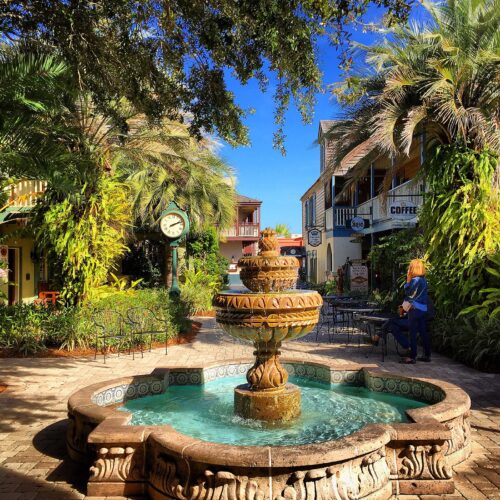
Fort Mose was abandoned and slowly faded back into the swamp. In 1964, the marsh where Fort Mose stood was declared a National Historic Landmark, and today there is a wonderful museum telling the story of the fort, pirates and the free people who lived here.
“Brethren of the Coast”
Also to our interest looking at the “Brethren of the Coast,” as they called themselves, is the St. Augustine Pirate & Treasure Museum. This is the largest and most authentic collection of pirate artifacts ever displayed under one roof.
Of course, there are not many pirate artifacts! Most of the pirates were hung or killed in battle (Blackbeard went down with five bullet holes and 20 sword cuts, and they sliced off his head for good measure).
There are not a lot of genuine artifacts, but you can see Blackbeard’s blunderbuss, one of the three remaining “Jolly Roger” pirate flags, the world’s oldest wanted poster, and Captain Thomas Tew’s original treasure chest – the only known authentic pirate chest in existence.
The museum does a fun job of detailing the lives of the most outrageous corsairs, and kids can fire a video cannon, see Disney-produced special effects show on Blackbeard’s last battle, and stare at the actual sword used by Captain
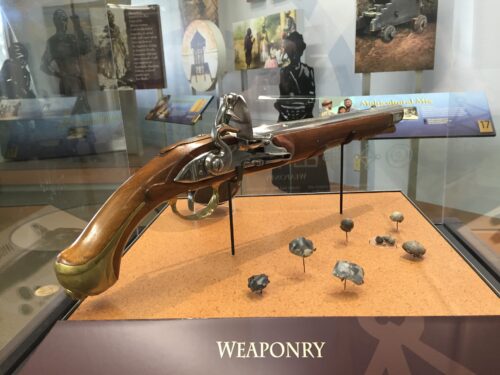
Jack Sparrow in the movie Pirates of the Caribbean. The sword spins in a special case with dramatic lighting as if it were a priceless relic from King Tut’s Tomb. Which to some people, it is.
Real Pirate Treasure Exhibits
Most interesting are the exhibits of real treasure including pieces of gold, gold bars, pearls, and silver, recovered from pirate shipwrecks, including Blackbeard’s own flagship, the “Queen Anne’s Revenge.”
The museum is just one of a half dozen pirate adventures in St. Augustine. Up to a dozen, fully outfitted pirates stroll around town posing for pictures, and there are pirate shows, a pirate sailing tour of the harbor, and pirate, ghost, and graveyard walking tours.
St. George Street, the cobblestone, the car-free main street of town, looks like the setting of every pirate movie, with colonial buildings, pubs with wood signs, swaying palm trees, Spanish moss hanging from trees, and rustic old lanterns.
Yes, it’s a bit touristy, but much of it is authentic, and it’s certainly beautiful at night with the lanterns glowing and candles flickering in many of the windows.
Every March, there’s a re-creation of pirate Captain Robert Searle’s 1668 attack on St. Augustine. Reenactors of pirates and Spanish soldiers fight in the plaza, then all the people of the town and the soldiers flee up St. George Street while the pirates sack the city.
As fictional pirate Long John Silver would say to the re-enactors: “Them that die fast, will be the lucky ones.” They’ll be first at the bar.
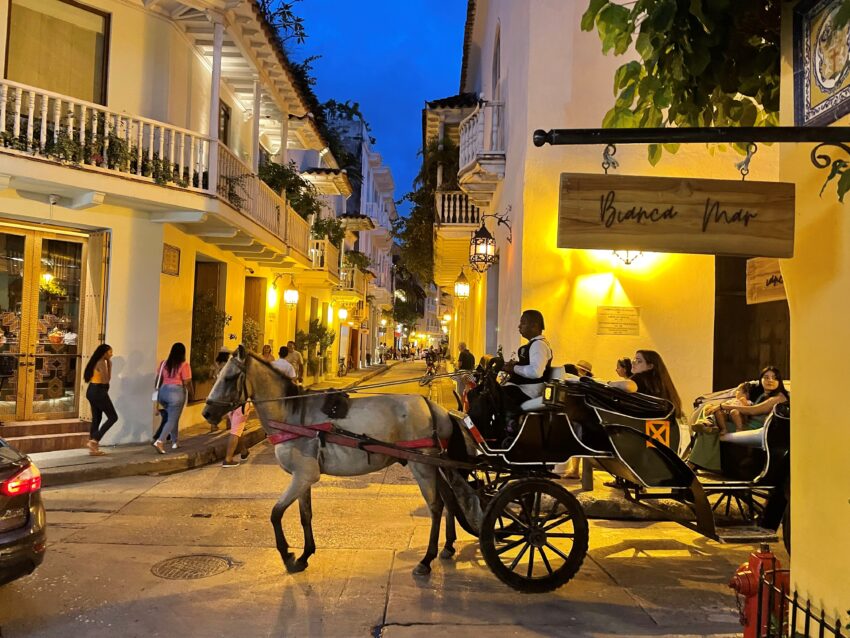
Cartagena, Colombia

In the late 1600s and early 1700s, all pirates headed to what was called the Spanish Main – the mainland of Central and South America.
The queen of the Spanish Main was Cartagena, a stronghold town where the Spanish would bring gold from Mexico, silver from Peru, and emeralds from Columbia and wait for a fleet of heavily armed warships to transport the treasures to Spain. Capturing Cartagena was the dream of all pirates.
And today, Cartagena lives up to that pirate dream. It is a wildly romantic and magical town surrounded by 11 km of stone walls lined with cannons.
Flower-Covered Balconies over Cobblestoned Streets
Home to the largest fortress in all of South America, it is also a town filled with flower-covered balconies hanging over cobblestone streets, all lit by historic lanterns.
At least two dozen horse-drawn carriages clatter throughout the historic district every night, where buildings in a rainbow of pastel colors house bars, wonderful and inexpensive restaurants, live music clubs, and trendy boutiques.
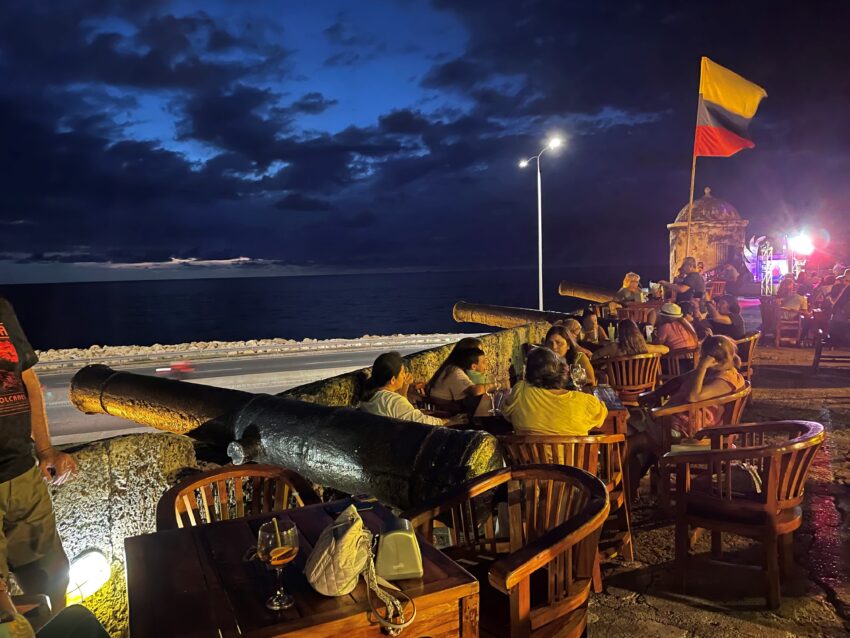
Dangerous? Of course not. Cartagena has become a major tourism destination for all of South America and a growing stop for cruise ships.
The new shopping mall (built in what was once a bullfighting ring) could easily fit into Rodeo Drive. Both regular police and special tourism police will be seen everywhere since the government of Columbia recognizes the economic importance of tourism and the importance of providing a safe tourism experience.
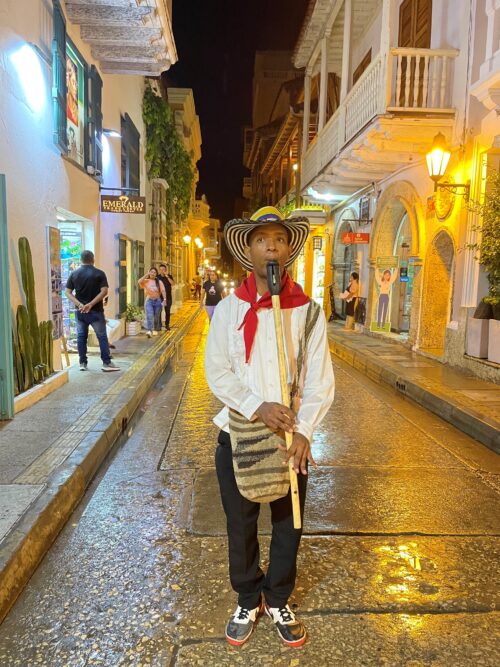
Touts Selling Everything
Of course, there are touts on the street selling hats, Cuban cigars, sunglasses, and “emerald” jewelry, but a firm “No gracias” scatters them like a blast from a blunderbuss. There are also kids selling ice-cold beers for $1 on every corner, and in the heat and humidity of Cartagena, they are a welcome sight.
Arriving in Colombia at the airport from Miami, I was in a long line at customs when a uniformed person asked my age.
Discovering I was over 65, he walked me to a special customs window with no lines that is strictly for senior citizens! Now, this is a country that appreciates tourism!
Sir Frances Drake in Cartagena
Certainly, Cartagena held a thrill to Sir Frances Drake, who attacked, captured, and sacked the city in 1586.
He secretly had the support of Queen Elizabeth I, but since England and Spain were at peace, he brought his fleet of 29 ships, 800 crew, and 1,600 soldiers into battle acting as a pirate – El Draque as the Spanish called him in fear and hatred.
The building Drake used as headquarters in Cartagena is still there. It was built in 1560 as Casa del Alba, one of the town’s first stone buildings.
It is impressive with its massive iron doors, though today they lead to a private seven-bedroom, eight-bath rental property that goes for $3,100 a night!
Casa Drake is a great place to begin a tour of the 11 km of stone walls that surround the old town.
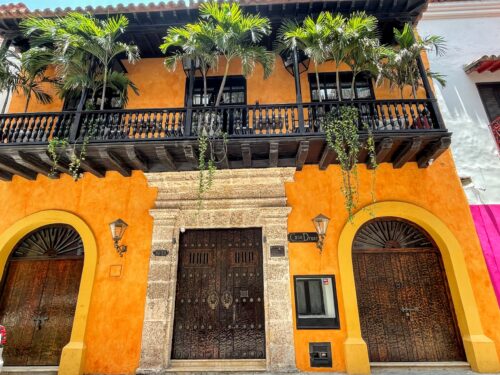
For sheer size, no pirate town can top the cannon-studded walls of Cartagena, and walking the ramparts of this UNESCO World Heritage Site is one of the town’s principal attractions.
A 20-minute walk outside the walls brings you to the incredibly massive San Felipe de Barajas Castle, which was built in 1657 and is the largest fortress in South America. Ironically, it was built away from the sea to protect Cartagena from attacks by land.
Why? Because that’s how Drake captured the city.
The 850-foot-high fortress was based on a “defense in depth” design, so if a lower part of the fortress was captured, the defenders could fall back to the next level and still shoot down on their enemies.
Today, as you climb higher up the ramparts, the views become grander. There are long tunnels you can walk through that were used to move troops around undercover.
Cartagena’s Hero: Blas de Lezo

And don’t miss the statue to Cartagena’s hero – Blas de Lezo — a Spanish Admiral who lost a leg, an arm, and an eye in battle.
Known as Patapalo “PegLeg,” he refused to wear an eyepatch and must have been a fearsome-looking character, but in 1741 he commanded the defense of Cartagena and defeated a huge British fleet and army.
He famously said, “If the King of England wants to come here, he’s going to need a bigger squadron.”
Of course, Cartagena has a pirate ship that does sunset cruises, and the Naval Museum has great exhibits, model boats, and dioramas showing the locations of ships and fortifications during all the pirate attacks and battles. Unfortunately, the museum is all in Spanish, but you can hire an English guide for $10.
A principal Cartagena attraction is to take a day trip by fast boat to Islas del Rosario, 27 small coral islands about 90 minutes away. There are many tour options.
Book a tour that includes lunch and make sure the boat has a covering against the brutal sun (and possible rain). You’ll have a day at a pirate Caribbean paradise with white sand beaches, hammocks, a tasty fried fish lunch, and palm trees.
And barbed wire fences. Each tour goes to its own beach compound, isolated from the others by fences. You can walk away from the water into the jungle, but not along the beach.
A better option, if you tire of the beach after a few hours, is once you land at your destination, hop on another ferry to Isla de San Martin de Pajarales, where there is an incredibly fun aquarium show in Spanish. There are sharks and jumping dolphins and you’ll join in the laughter, as a good pirate, even if you don’t understand a word of what’s going on.
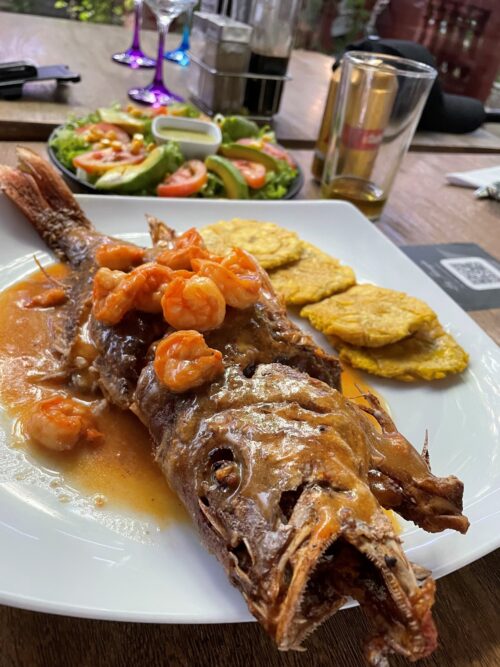
Palace of Inquisition
The final pirate attraction of Cartagena is the Palace of Inquisition. It is basically a museum of the torture instruments used by the Catholic Church in this building and others to extract confessions from the 800 cases of witchcraft and other crimes of which victims were accused.
Not one of the 800 tried was found innocent! Many were hung, burned, or beheaded. You can imagine my chagrin when discovering the museum was closed “for filming” during my four-day visit.
Here’s how the exhibits are described: “The principal method of torture was the strappado, where the victim was tied with their hands behind their back and suspended in the air whilst a series of weights and drops were added.
The other infamous torture method was the rack. Often just watching another victim being stretched on the rack was all it took to obtain a confession.
The museum also features such disturbing relics as thumb screws, the head crusher, and an iron collar covered in lethal spikes.”
Their brochure says the museum “was sure to satisfy any morbid curiosity.”
Well, it was not to be for me and my morbid curiosity. But as it turned out, visiting the exterior of the museum one night, I happened upon “the filming” that had temporarily closed it.
Turns out, it’s a major English motion picture starring James Franco as Fidel Castro, and the scene I saw had hundreds of extras.
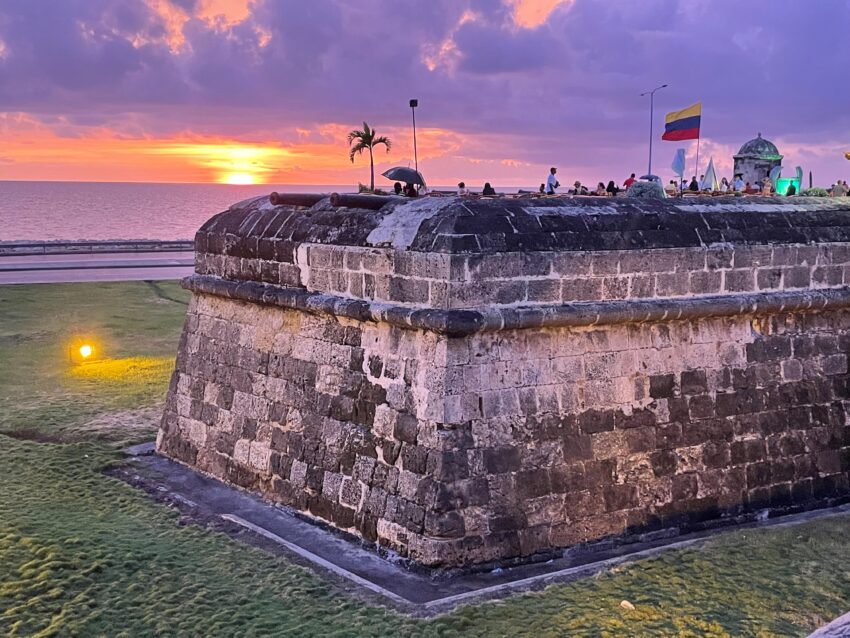
The museum “stood in” for a hotel, and Fidel was crushed by admirers as a fleet of 1960s cars brought him to the lobby in what was supposed to be Cuba. I didn’t see James Franco, but the 1960s limos were a nice substitute for an iron collar covered in lethal spikes.
San Juan, Puerto Rico
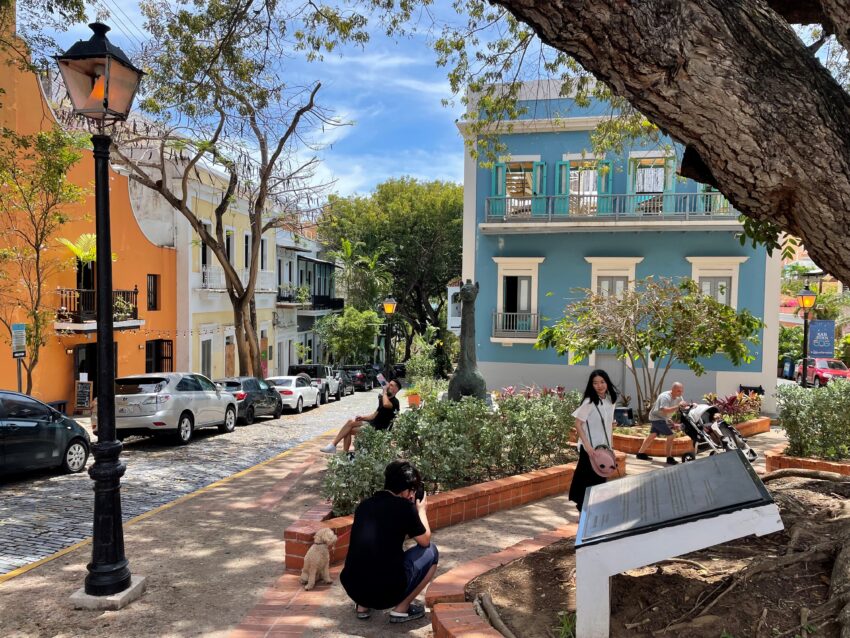
Poor San Juan. When I visited in May 2022, it had just recovered completely from the horror of Hurricane Maria in 2017. Some 2,900 people were killed during that storm, which had sustained winds of 155 mph with rainfall of 5 to 10 inches and caused $90 billion of damage including huge power outages for weeks and even months.
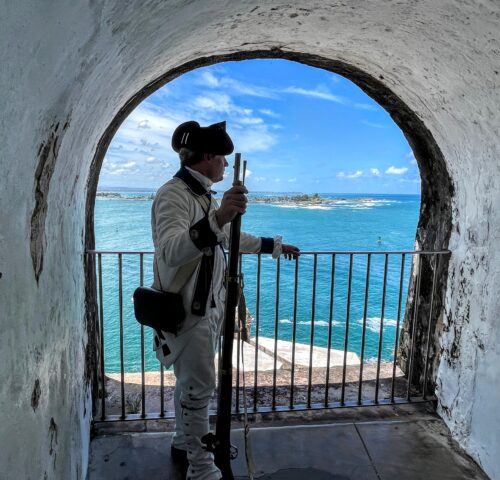
As a comparison, the recent Hurricane Fiona, which struck on Sept. 18, 2022, was only a Category 1 with winds of 85 mph, caused only one fatality, and within days, saw the reopening of most golf courses and attractions.
And what attractions there are!
Old San Juan is a fortified peninsula that juts into the Caribbean like a thumb and is surrounded by stone walls. It is simply one of the most beautifully historic cities in the world.
The water here is sparkling blue, beaches begin at the edge of the fortified stone walls, every house is painted a different pastel color and covered with flowers, there is a casino, big-name hotels from every luxury brand, and (fittingly for a pirate town) the world’s largest rum distillery – Bacardi’s – which offers tours and samples.
Even the historic streets (Adoquines) are colorful. They are made of blue bricks that were stone cast from furnace slag and brought over on Spanish ships as ballast. Under the light of flickering lanterns, they glow with a blue color you have never seen on a street.
Four Cruise Ship Piers
San Juan is hardly undiscovered. There are four huge cruise ship piers right in the old town that can accommodate the world’s largest cruise ships; some, like Wonder of the Seas, can disembark an invading force of nearly 7,000 passengers at one time!
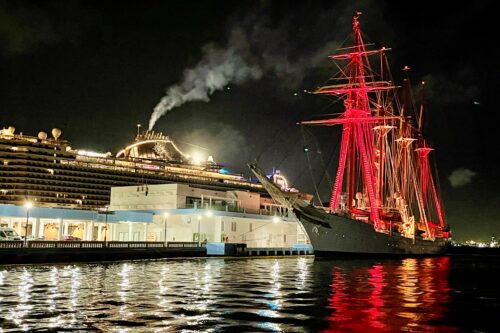
But no pirate tale is complete without San Juan. In the days of sailing ships, the town’s deep, land-locked harbor could be easily defended. Most important, Puerto Rico was at the very eastern edge of the curving chain of Caribbean islands known as the West Indies. San Juan was not on the cargo route of treasure ships, but it was the entrance to the Caribbean.
King Philip IV of Spain called it “the front and vanguard of all my West Indies …the most important of them all and the most coveted by my enemies.”
And as a result, the most fortified. The old town has not one, but two incredible fortresses, now maintained by the National Park Service. There are simply no other fortresses, anywhere, with this type of interpretation in English.
Stand on the ramparts and you can still feel the trade winds that blew ships here from Europe as you look at more than a mile of stone walls in both directions. This was a true “defense in depth” system.

The Castillo San Felipe del Morro (“El Morro – the Bull”) provided a crossfire against ships trying to enter the harbor, while Castillo San Cristobal protected the town from land. Drake attacked and failed in 1595, as did Sir Ralph Abercromby with a British fleet in 1797. The Dutch took and burned the town in 1625, but ultimately Puerto Rico – the “Rich Port” was successfully defended through history with state-of-the-art fortifications, mostly still in place.

Beyond walking the walls and visiting the forts, part of the fun of San Juan is partying in neighborhoods where pirates would have felt at home. A decade ago, La Perla might not have been safe.
This is the historic neighborhood below the walls – a place where originally slaves were forced to live since they were not allowed in the main city.
You can get guided tours of La Perla, but we explored on our own and found it safe, colorful, and fun with bars and music. As with any city, caution and practical sense prevail, but this San Juan neighborhood is far cry from the cruise ships, though it is only a half-hour walk away.

La Placita neighborhood is a must. While historic, it is from the 19th century, not the days of pirates. But it is filled with late-night salsa dancing in the streets, live music everywhere, dozens of outdoor bars serving drinks, and the devil-may-care spirit of buccaneers.
As you sit in this plaza, surrounded by people drinking daiquiris, Mojitos, Captain’s Punch, and other rum drinks – it is ironic to remember that the Spanish in pirate days did not drink rum. That was the drink of the English. And perhaps it was rum that made the difference.
Because although Spain ruled the Empire with the three fortified bastions noted in this article, as well as in Havana and Panama, they never defeated the pirates, who in swift, heavily armed boats sailing from remote islands were able to constantly be a thorn in the side of Spain.
No, the only ones who could eventually defeat the pirates were the English. But that’s another story, coming soon in Part II – “The Swashbuckling Pirate Towns of the British Americas.”
- Oklahoma City and the Protest Movement - February 15, 2024
- California, We Still Love You - August 31, 2023
- Western Gunfighting Towns You Gotta See - March 25, 2023


